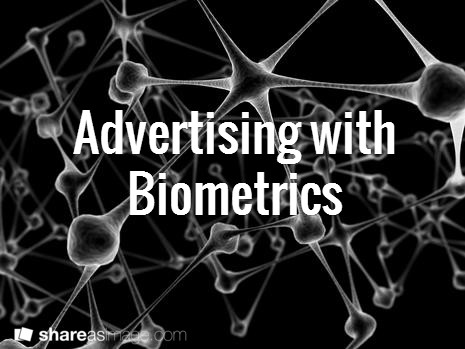
I’ve mentioned in a previous post that I’m interested in a variety of research techniques, not least of which is biometric research. For this two-part post, I’d like to share some results from past studies I have conducted.
As a prelude, I should note that there are various types of biometric and neurometric research approaches; using caps, belts, fMRI machines, etc. etc. But regardless of the technique, I basically like to try and measure people’s non-conscious reactions to online content (and advertising) and I do this because 95% of our reactions and decision-making occurs on a non-conscious level (if you doubt this, check out Habit by Neale Martin). So, what better way to figure out what’s going on under the hood than going direct to the source?!
One of the studies I conducted in the past specifically looked at the impact of various targeting techniques associated with online display advertising. When designing this research, one of the first questions I asked myself in trying to understand non-conscious reactions associated with online targeting techniques was:
‘What is the underlying impact of ads that are targeted to be personally relevant?’
I suspected that when ads were relevant to an individual, that those ads would get noticed more, simply because they are relevant. I also thought that I would be able to point to this ‘notice level’ as a potential driver of the positive brand impact I had seen over hundreds of brand impact studies spanning several years. So, I ran the study to test out that basic hypothesis and… well… I was wrong! Bummer, but it was bound to happen one day ;-).
When I looked at the data, comparing people who were served a personally relevant ad versus those that were served a different kind of ad – there was actually no detectable difference in the level of ‘noticing’ the ad on the page (noticing = looking directly at it for 2+ seconds). What the research did find, however, is that when an ad is relevant to an individual, they typically:
1. Spend around 25% longer fixating on it (vs. non-relevant ads), and
2. Demonstrate an average 27% increase in pupil dilation while looking at the ad (which is a big increase for this measure)
The first point is reasonably straight forward and relates to their potential to absorb the information because they are looking at it for longer. But what really caught my attention was the pupil dilation change in the second point.
Pupil dilation has been well established as an indicator of increased cognition, not least of which is built upon the work of Nobel Prize laureate Daniel Kahneman. For those of us without Nobel prizes hanging from the fireplace, this observation basically means that people mentally process and think about ads more deeply when they are personally relevant, how about that!
Knowing that increases in real-time cognition can be triggered is a very valuable insight for marketers. This means we can start to adjust the media plan, the targeting and the creative-type to match people’s mind-state and interests. In plain English, this means rather than showing the same ad to everyone on your media plan, you can start to optimize receptivity to certain types of ads (specifically more involved ad units such as super rich media) by targeting them to be personally relevant rather than buying purely based on context or environment.
If you are wondering what exactly constitutes ‘personal’ relevancy in online contexts, this can be anything from search retargeting, purchase-based targeting or even interest-based targeting derived from social network preferences. Anything that gets a marketing communication in front of someone to whom it is relevant is counted as personally relevant and this is the case regardless of context. For example if you are in the process of looking to buy a house, ads that pertain to home loans and real estate agents will be the ones that you are likely to engage-with more deeply regardless of the environment in which you see them. I should also point out that the other effect that is observed here is that people actually like these ads more when targeted in this way, how’s that for win/win?!
At this point you might be asking yourself ‘ok I get it, this type of relevancy elicits a deeper level of thought and probably engagement, but does this mean that the environment of ad exposure doesn’t matter’? ‘What about contextual relevancy, is this important’? Well, stay tuned for my next post and we can talk about that and more…